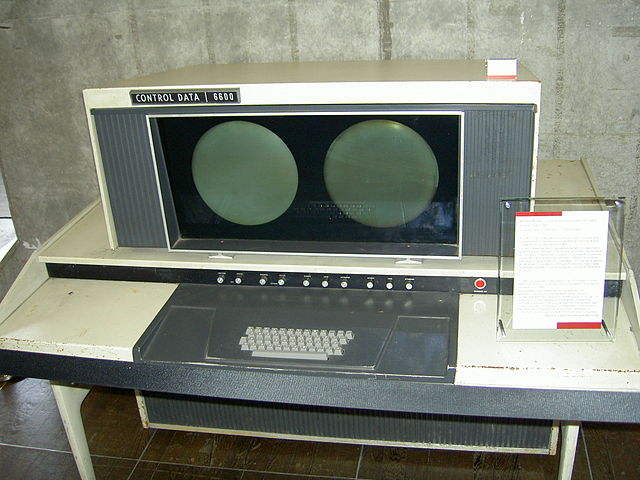The CDC 6600 was the flagship of the 6000 series of mainframe computer systems manufactured by Control Data Corporation. Generally considered to be the first successful supercomputer, it outperformed the industry's prior recordholder, the IBM 7030 Stretch, by a factor of three. With performance of up to three megaFLOPS, the CDC 6600 was the world's fastest computer from 1964 to 1969, when it relinquished that status to its successor, the CDC 7600.
The CDC 6600. Behind the system console are two of the "arms" of the plus-sign shaped cabinet with the covers opened. Individual modules can be seen inside. The racks holding the modules are hinged to give access to the racks behind them. Each arm of the machine had up to four such racks. On the right is the cooling system.
A CDC 6600 system console. This design was a major innovation, in that the screens and keyboard replaced hundreds of switches and blinking lights common in contemporary system consoles. The displays were driven through software, primarily to provide text display in a choice of three sizes. It also provided a way to draw simple graphics. Unlike more modern displays, the console was a vector drawing system, rather than a raster system. The consoles had a single
A CDC 6600 cordwood logic module containing 64 silicon transistors. The coaxial connectors are test points. The module is cooled conductively via the front panel. The 6600 model contained nearly 6,000 such modules.
The CDC 6000 series is a discontinued family of mainframe computers manufactured by Control Data Corporation in the 1960s. It consisted of the CDC 6200, CDC 6300, CDC 6400, CDC 6500, CDC 6600 and CDC 6700 computers, which were all extremely rapid and efficient for their time. Each is a large, solid-state, general-purpose, digital computer that performs scientific and business data processing as well as multiprogramming, multiprocessing, Remote Job Entry, time-sharing, and data management tasks under the control of the operating system called SCOPE. By 1970 there also was a time-sharing oriented operating system named KRONOS. They were part of the first generation of supercomputers. The 6600 was the flagship of Control Data's 6000 series.
Open panels of the CDC 6500 undergoing restoration at Living Computers: Museum + Labs in Seattle.
CDC 6600 computer. Display console shown in the foreground, main system cabinet in background, with memory/logic/wiring to the left and middle, and power/cooling generation and control to the right.
Console for CDC 6600
Operator console of the CDC 6400 with four magnetic tape memory units in the background with a magnetic tape controller unit in front of them at the Rechenzentrum (Computer Center) of RWTH Aachen University, Germany (1970).







